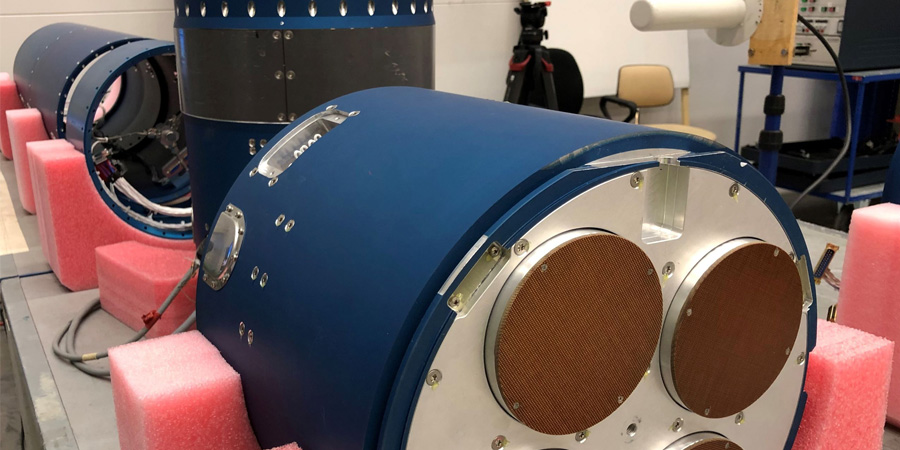G1 watch, far side CME, BROR rocket campaign
Monday, 13 March 2023 18:44 UTC

Quite the surprise this morning as proton levels at the near Earth environment suddenly started to rise this morning and even crossed the minor S1 solar radiation storm level. This was all the result of a major far side coronal mass ejection which you can see in the animation below which we posted on our Twitter account. Be sure to follow us and like the post! Magnetic field lines from the Parker Spiral managed to send some protons our way causing us to cross the minor S1 solar radiation storm level causing minor disturbances in HF radio communications at high latitudes. While impressive, the plasma cloud is of course aimed away from our planet and no further effects should be expected from it.
Today's minor S1 solar radiation storm was caused by this major far side coronal mass ejection. The plasma cloud is not aimed at Earth but solar protons did manage to reach our planet thanks to the Parker Spiral. pic.twitter.com/ijpQSWyf9x
— SpaceWeatherLive (@_SpaceWeather_) March 13, 2023
G1 geomagnetic storm watch
The NOAA SWPC has issued a G1 geomagnetic storm watch (max Kp of 5) for Wednesday, 15 March. Based on their latest forecast they expect two minor coronal mass ejections to pass our planet and the onset of a solar wind stream from a coronal hole. Something to look out for if you are at a high latitude location.
BROR rocket campaign
SpaceWeatherLive.com presents LIVE coverage on our YouTube channel of the BROR sounding rocket launch from Kiruna, Sweden. This rocket will create colorful clouds at the edge of space and will be used to study the interaction of space weather with our planet. It should be a very special sight to behold. The first launch attempt was yesterday (Sunday 12 March) but was scrubbed at the last moment due to high winds at higher altitudes. We thank everyone that turned up to live stream and hope you will tune in again during the next launch attempt. The campaign will last until Wednesday, 22 March and requires good weather for it to go trough. Weather forecasts are looking grim right now and the next possible launch window will likely be on Thursday evening (16 March) or Friday evening (17 March) purely based on the weather forecasts that are available now. For more information read the mission info below provided by the SSC - Swedish Space Corporation:
SSC and a group of auroral scientists from the Swedish Institute of Space Physics (IRF) will launch a sounding rocket from Esrange to create colorful clouds for aurora studies. On 12 March a first attempt will be made to launch BROR, a research rocket with the aim of studying conditions in near-Earth space. The onboard experiment will create unusual and beautiful light phenomenon.
“To succeed in the scientific experiment, IRF will use techniques similar to that found in fireworks, which the sounding rocket will activate when it is at an altitude of over 100 kilometers”, says Tima Sergienko, IRF scientist who is Principal Investigator of the experiment.
The activation will occur in space closest to the Earth, the ionosphere, creating beautiful light phenomena that will be studied with a unique network of advanced optical imaging stations in the Kiruna area.
The data from the experiment will be used by IRF scientists in Kiruna to study conditions in near-Earth space which is an important piece of the aurora research puzzle that can enable better forecasts of the Sun’s activity and how its solar wind of charged particles affect critical infrastructure on Earth and satellites.
“We are excited to have developed this sounding rocket experiment for IRF and their research and to launch it into space. SSC has a long history of conducting aurora research missions at Esrange, dating all the way back to the 70’s. Thanks to the technological developments in recent years, we can now break old ground to help us understand more about northern lights,” says Krister Sjölander, Vice President Science Services and Head of Payloads & Flight Systems at SSC.
This mission is funded by SNSA, within the Swedish national balloon and rocket program, where Swedish science community is offered the opportunity to do research in Space from Esrange. Similar scientific experiments for aurora studies have been done before by NASA.
Subscribe to our YouTube channel to not miss a thing!
Header image: Preparations are made on the BROR rocket. (SSC)
Thank you for reading this article! Did you have any trouble with the technical terms used in this article? Our help section is the place to be where you can find in-depth articles, a FAQ and a list with common abbreviations. Still puzzled? Just post on our forum where we will help you the best we can!
Latest news
Latest forum messages
Support SpaceWeatherLive.com!
A lot of people come to SpaceWeatherLive to follow the Sun's activity or if there is aurora to be seen, but with more traffic comes higher server costs. Consider a donation if you enjoy SpaceWeatherLive so we can keep the website online!

Space weather facts
| Last X-flare | 2025/05/14 | X2.7 |
| Last M-flare | 2025/05/15 | M2.1 |
| Last geomagnetic storm | 2025/05/03 | Kp5 (G1) |
| Spotless days | |
|---|---|
| Last spotless day | 2022/06/08 |
| Monthly mean Sunspot Number | |
|---|---|
| April 2025 | 140.6 +6.4 |
| May 2025 | 73.4 -67.2 |
| Last 30 days | 100.7 -22.3 |


